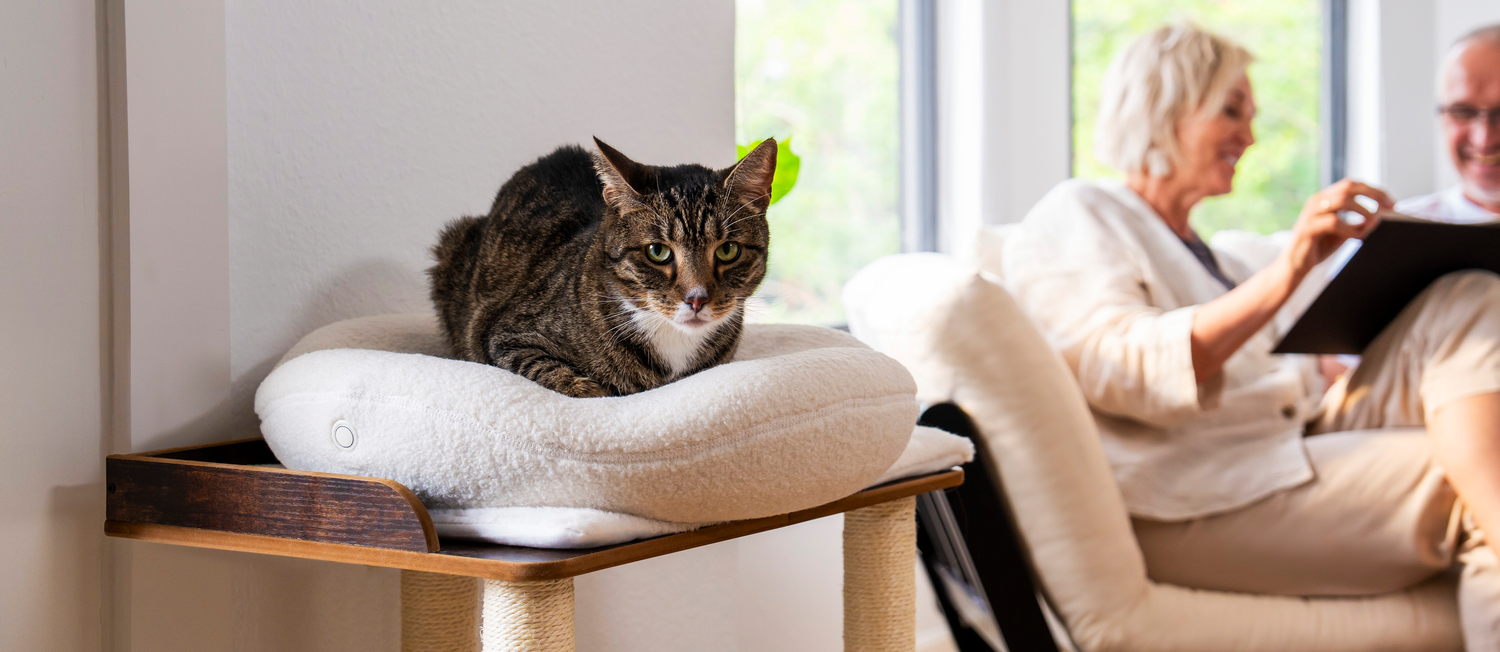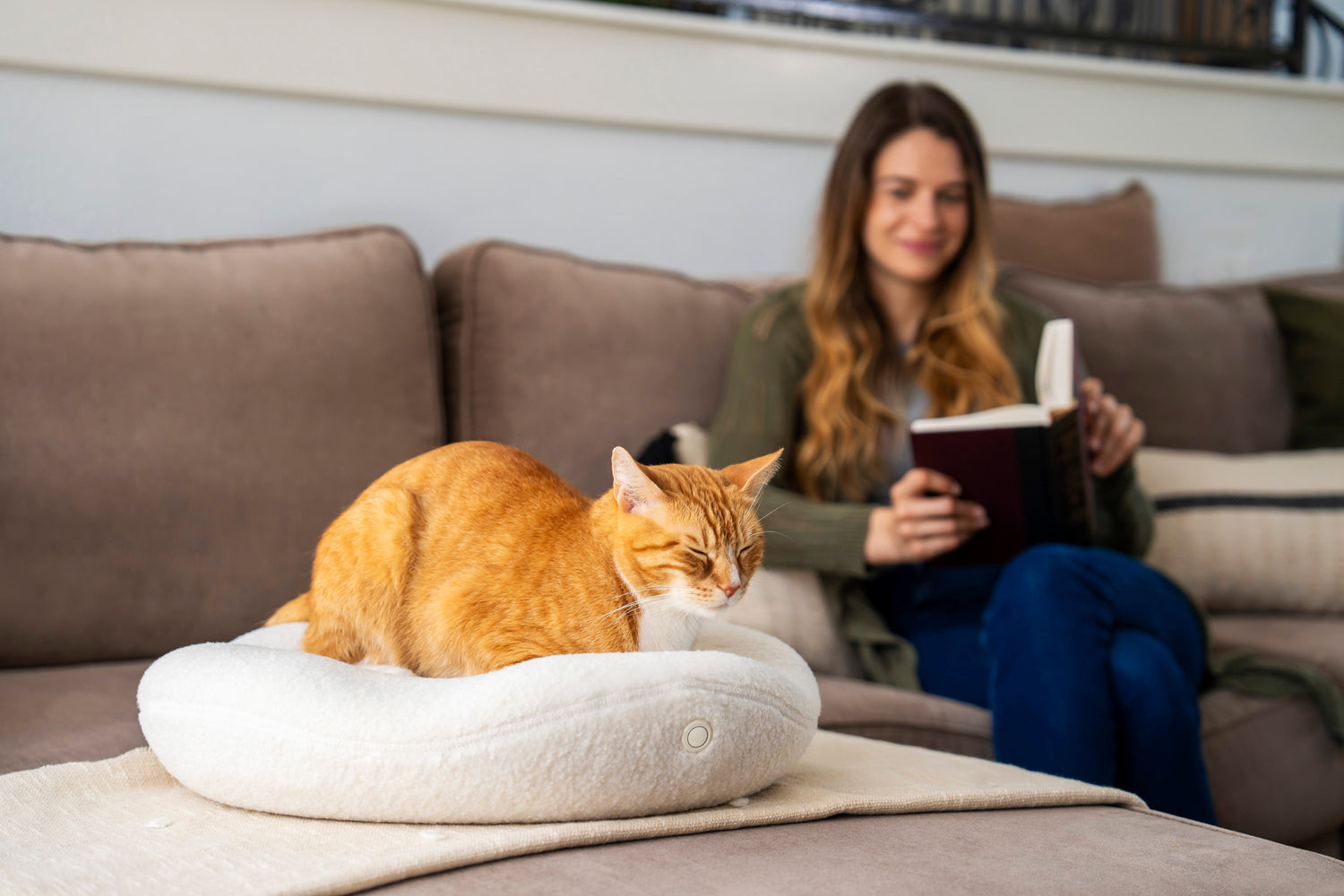Much like pet strollers and novelty scratching posts, a heated cat bed may seem like a splurge. But it’s not just a luxury — it’s a must for a cat’s comfort. A well-designed heated pet bed can improve your cat’s quality of life by offering pain relief and a sense of security. Plus, cats naturally seek warm places to snooze. A heated pet bed can keep them off your computer or your freshly cleaned clothes.
We consulted a cat behaviorist & researcher to explain why your cat needs a specially-designed heated bed. Keep reading to discover how a heated cat bed can enhance your pet’s health and well-being throughout all of their nine lives.
Cats Crave Warmth Because it’s in Their Biology
Think about where your cat likes to nap: on a sunbeam in the living room, in laundry fresh out of the dryer, or on a charging laptop. But why do cats like warmth? It all comes down to biology. The average body temperature for a cat is between 101°F and 102.5°F (38.3°C and 39.2°C).
Meanwhile, the ideal thermoneutral zone (TNZ) for a cat is 86°F to 100°F (30°C to 38°C). This is the ambient temperature range at which cats are most comfortable because they won’t have to expend their energy to warm up or cool down.
While a cat’s fur does provide insulation, it doesn’t generate heat. Thus, cats seek external heat sources to maintain a TNZ that’s just right.
Cats’ love for warmth is hardwired into their biology. As descendants of desert-dwelling ancestors, felines evolved to conserve energy by seeking external heat sources. By basking in warm spots, cats reduce the calorie expenditure needed to stay warm, which aligns with their natural "energy-efficient" lifestyle of intermittent activity. — Dr. Lingna Zhang, Cat Behaviorist & Researcher
Why Use a Heated Cat Bed Instead of a Heating Pad?
A natural solution to keeping your cats warm (and out of your clean laundry) is to give them an external heat source they can safely lie on. Many cat parents opt for a heating pad to coax their cats away from sleeping on things they shouldn’t, but here are the reasons why you should use a specially designed heated cat bed instead:
-
If Offers Gentle, Consistent Warmth
With an electric heating pad designed for humans or a microwaveable heating pad, it can be difficult to discern when it’s too hot for a cat’s comfort. A heated cat bed maintains a steady, cat-friendly temperature to maintain a cat’s ideal TNZ. -
It’s Made Safe for Cats
Electric heating pads designed for humans pose a burn risk, and they may not be entirely pet-proof. Safety features such as chew-resistant cords, built-in timers, and low-voltage heating elements will keep your cat safe and cozy. -
It’s Made for a Cat’s Overall Comfort
Unlike a standard heating pad, a heated pet bed is designed to support a cat’s unique sleeping positions with an adaptable foam inner layer and a soft outer cover. This thoughtful design will ease your cat’s joints while keeping them at a suitable temperature. -
It’s Easy to Place in Your Home
A well-designed heated cat bed seamlessly blends into the aesthetic of any home, so it’ll fit in whatever area your cat likes to lounge. Look for a heated bed with a removable cover you can throw in the washing machine — cats are fastidious creatures and prefer to lie in clean spaces.
A heated cat bed provides more support than a heating pad and is likely more comfortable, too. Resting areas are a resource for cats, and we want to make sure they have their own. (Plus, having cat hair all over your electronics is probably not a goodidea.) — Dr. Lingna Zhang, Cat Behaviorist& Researcher
Did you know: Vets often use heated beds for cats post-surgery to stabilizebody temperature and speed recovery. — Dr. Lingna Zhang, Cat Behaviorist& Researcher
A Heated Cat Bed Supports Cats at Every Life Stage
No matter your cat's age, a heated cat bed offers several physical and psychological benefits:
-
A Crucial Heat Source for Kittens
Kittens under four weeks old aren’t able to regulate their body temperature on their own, making a heated cat bed a necessary source of heat and comfort. Heat also helps ease separation anxiety in weaned or orphaned kittens by mimicking their mother’s warmth, providing a sense of safety as they transition from kittenhood to adulthood. -
A Stress Reliever for Nervous Cats
Cats associate warmth with security. A heated cat bed can become a safe space for cats that are in an unfamiliar environment or adjusting to a change in their living arrangements, such as the arrival of a new family member or a home renovation. -
A Way to Soothe Aches in Senior Cats
Older cats are prone to joint problems from arthritis and poor circulation. Veterinary research shows that approximately 60% of cats over the age of six exhibit signs of arthritis1 — and another study shows this rises to around 90% in cats over age 122. Gentle heat from a therapeutic cat bed for arthritis can help ease joint discomfort and increase blood flow. -
A Recovery Tool for Cats Post-Surgery
To stabilize body temperature and speed up recovery, vets will often place cats on a heated surface. A heated pet bed will provide additional support for your cat’s at-home recovery efforts. -
A Cozy Oasis for Cats All Year Round
If you live in an area with harsh winters or cooler temperatures year-round, a heated cat bed is a logical choice. However, it’s also helpful in the summertime if you continuously run your air conditioner to cool your home. (Remember that cats are more sensitive to lower ambient temperatures than humans.)
While conventional wisdom suggests that heated cat beds are only necessary in winter, they can also be highly beneficial during the summer, especially when indoor air conditioning keeps temperatures low. — Dr.Lingna Zhang, Cat Behaviorist & Researcher
Can Outdoor Cats Use a Heated Cat Bed?
Cats that live outside can use a heated bed, just like their indoor friends. (Most importantly, it’ll help prevent hypothermia during colder months.) Look for a model with a chew-resistant power cord and a waterproof cover. Place the bed in a sheltered area such as a garage, covered porch, or an insulated cat house to deter wildlife.
Final Thoughts on Why Your Cat Needs a Heated Cat Bed
Cats are naturally drawn to warmth because it’s built into their biology, but the heat does more than make them feel good. It also eases anxiety, soothes aches and pains, and promotes a comfortable ambient temperature.
A heated cat bed provides a just-right level of comfort, and the best ones are thoughtfully designed to keep your cat safe and comfortable while blending effortlessly into your home.
The Knead Therapeutic Cat Bed is Unapologetically Made for Cats

Support your cat’s comfort and well-being with the Knead Therapeutic Cat Bed — a heated, orthopedic bed made with their unique needs in mind.
About Our Expert
Lingna Zhang, PhD: Dr. Zhang earned her PhD in animal physiology, behavior and welfare from Texas Tech University in 2019. Today, she works as a researcher at South China Agricultural University and previously served as an assistant research professor at the Translational Neuroimaging and Systems Neuroscience Lab at the Penn State Department of Biomedical Engineering.
1. L.I. Slingerland, H.A.W. Hazewinkel, B.P. Meij, Ph. Picavet, G. Voorhout,
Cross-sectional study of the prevalence and clinical features of osteoarthritis in 100 cats,
The Veterinary Journal, Volume 187, Issue 3, 2011
https://doi.org/10.1016/j.tvjl.2009.12.014
2. Knights, Chancie The New Science of Osteoarthritis Pain. Fall, 2021
https://www.researchgate.net/publication/355924543_The_New_Science_of_Osteoarthritis_Pain



